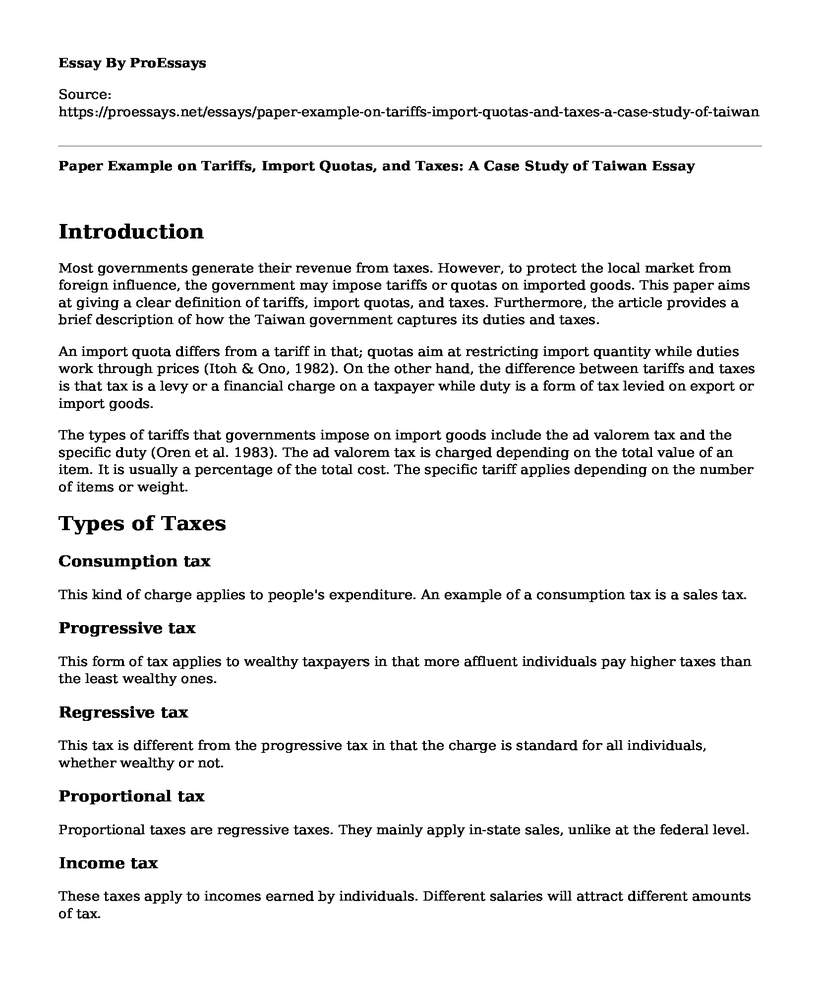Introduction
Most governments generate their revenue from taxes. However, to protect the local market from foreign influence, the government may impose tariffs or quotas on imported goods. This paper aims at giving a clear definition of tariffs, import quotas, and taxes. Furthermore, the article provides a brief description of how the Taiwan government captures its duties and taxes.
An import quota differs from a tariff in that; quotas aim at restricting import quantity while duties work through prices (Itoh & Ono, 1982). On the other hand, the difference between tariffs and taxes is that tax is a levy or a financial charge on a taxpayer while duty is a form of tax levied on export or import goods.
The types of tariffs that governments impose on import goods include the ad valorem tax and the specific duty (Oren et al. 1983). The ad valorem tax is charged depending on the total value of an item. It is usually a percentage of the total cost. The specific tariff applies depending on the number of items or weight.
Types of Taxes
Consumption tax
This kind of charge applies to people's expenditure. An example of a consumption tax is a sales tax.
Progressive tax
This form of tax applies to wealthy taxpayers in that more affluent individuals pay higher taxes than the least wealthy ones.
Regressive tax
This tax is different from the progressive tax in that the charge is standard for all individuals, whether wealthy or not.
Proportional tax
Proportional taxes are regressive taxes. They mainly apply in-state sales, unlike at the federal level.
Income tax
These taxes apply to incomes earned by individuals. Different salaries will attract different amounts of tax.
Property tax
This tax applies to homes, real estates, or lands.
Capital gains
These kinds of taxes apply to investments. By selling investments such as real estates, a levy applies to the capital gains after the sale.
The government can capture taxes or tariffs by setting laws and regulations related to a specific type of charge in Taiwan. The legislative Yuan formulates and revises rules related to taxation. A form of such legislation is the Income Tax Act which governs personal incomes.
Conclusion
This paper gives a summary on taxes, tariffs and quotas and how governments play a part in protecting their local markets from external exploitation.
References
Itoh, M., & Ono, Y. (1982). Tariffs, quotas, and market structure. The Quarterly Journal of Economics, 97(2), 295-305: https://hermes-ir.lib.hit-u.ac.jp/rs/bitstream/10086/7681/1/HJeco0440100150.pdf
Oren, S. S., Smith, S. A., & Wilson, R. B. (1983). Competitive nonlinear tariffs. Journal of Economic Theory, 29(1), 49-71: https://www.business.unsw.edu.au/About-Site/Schools-Site/Economics-Site/Documents/G%20Aryal%20-%20An%20Empirical%20Analysis%20of%20Competitive%20Nonlinear%20Pricing.pdf
Cite this page
Paper Example on Tariffs, Import Quotas, and Taxes: A Case Study of Taiwan. (2023, Apr 24). Retrieved from https://proessays.net/essays/paper-example-on-tariffs-import-quotas-and-taxes-a-case-study-of-taiwan
If you are the original author of this essay and no longer wish to have it published on the ProEssays website, please click below to request its removal:
- Essay Sample on Causes of the Financial Crisis
- Impact of the Great Depression on United States Culture - Essay Sample
- Comparative Analysis of Asian Immigration to the U.S. Essay Example
- Sexual Harassment in the Workplace: A Case Study
- Essay on Money Laundering: Destructive Risk to State, Banks and Community
- Essay Example on Exploring the History of Rock Art in China
- Paper Example on Parole Rule: Oral Negotiations Not Binding in Contract







